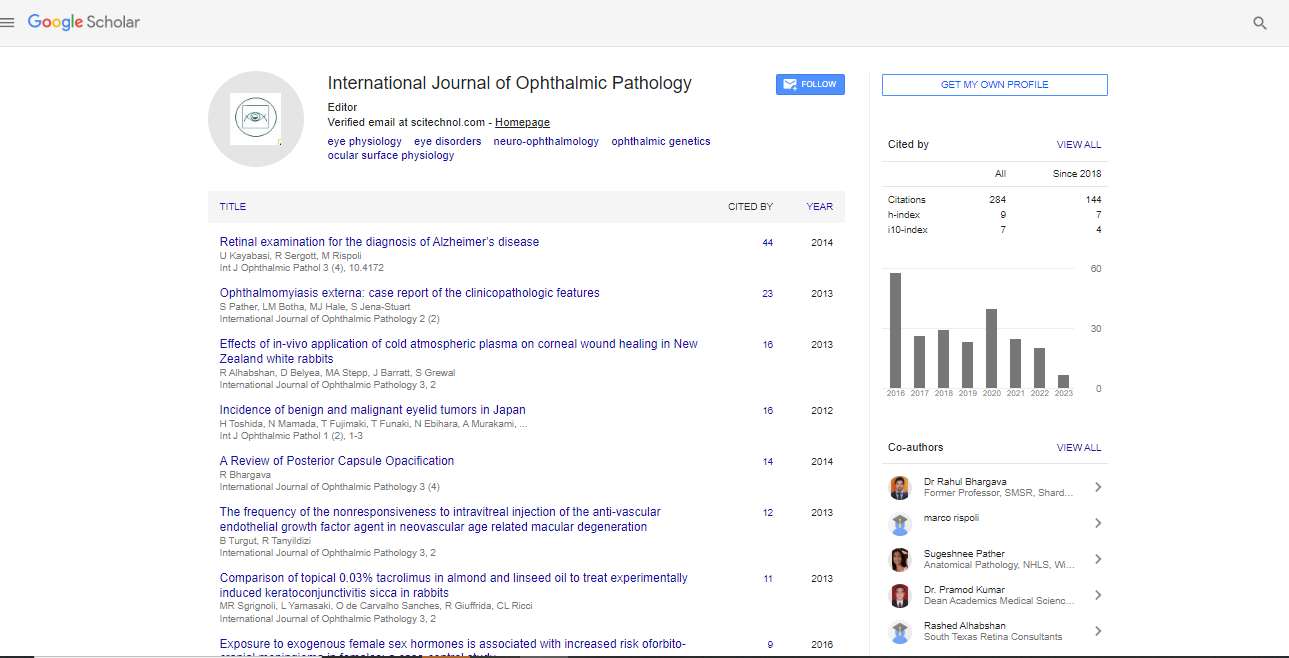Novel Data About Larval Stage of a Trematoda That Cause Visual Threatening Intraocular Granuloma in Rural Children in Egypt
Khalid G. Abu Eleinen, Mahmoud A. Kamal, Ahmed H. Nadar, Azza I. El- Adawy Amany, A. Abd Elaal Hany H. Lotfy, Ahmed A. Kotb Rehab, A. Abdelhai Adham, A. Alatyar Mostafa, A. Sheble Aser, M. Noman Marwa Ahmed El-Dardiry
Cairo University, Egypt
: Int J Ophthalmic Pathol
Abstract
Purpose: To detect the cause and treatment of a common pediatric granulomatous uveitis in Egypt associated with pathognomonic creamy whitish pearl like nodule grossly seen in the eye. Methods: Prospective multicenter study of cohort of patients presenting in the period between June 2013 to June 2020 from rural areas with granulomatous anterior uveitis and anterior chamber nodules. All patients underwent medical treatment, surgical removal was done for persistent and recurrent active uveitis. Molecular, histopathologic analysis and electron microscopy were performed for some of the excised granulomata. Results: The study included 487 eyes of 477 patients 476 eyes (97.7%) belonged to males and 11 were girls. Age range was 5-21, average of 8.5 years. All the patients presented with anterior chamber granuloma and active uveitis. Patients received medical treatment in the form of topical and systemic steroids, topical cyclopentolate and antibiotics. After initial medical treatment, 158 eyes (32.5%) had persistent intraocular inflammation, 2 eyes of them were initially blind, while 329 eyes (67.5%) responded to medical treatment with initial resolution of uveitis, 23 of them (4.7%) showed no recurrence of activity and 306 eyes (62.8%) had recurrence. Surgical excision of granuloma was done for 462 eyes (94.87%) with recurrent active uveitis or resistance to medical treatment. The inflammation subsided with no recurrence of nodules throughout the follow up period that ranged from 1 to 7 years. Nine patients had simultaneous cataract extraction with intraocular lens implantation. Polymerase chain reaction detected the presence of trematode DNA in 8 out of 13 examined nodules using primer pairs specific for mitochondrial cytochrome oxidase C, while results of histopathologic smear examination showed an inflammatory reaction of aggregates of eosinophils and epithelioid granulomatous inflammatory cells. Transmission electron microscopy (TEM) was done. Five samples revealed active eukaryotic creatures with clear intact energetic cellular organelles as well as numerous nuclei encircling within a syncytial layer and enclosed by a hyaline cover lined by granular layer rich in mitochondria. Six samples showed signs of inactivity in the cellular and the covering portions, while just an inflammatory reaction was seen in the remaining 11 samples. Fine muscle fibers contain electron-dense spiny structures appeared in variable directions in the central part of the removed ocular lesions. Conclusions: Due to structural similarity, these findings suggest ocular parasitic infestation with active spiny metacercaria of waterborne Trematoda of Diplostomum spp. which primarily affects a wide range of freshwater fishes to be finally as adults in a wide range of birds. To cure uveitis, Surgical excision was mandatory in most cases. Keywords: Inflammation, Anterior chamber, Iris, Granulomatous uveitis in children, Pearl granuloma, Trematoda, Rural Egypt
Biography
Khaled G Abu Eleinen is a renowned Ophthalmology Professor. Khaled G Abu Eleinen is working in Department of Ophthalmology, Faculty of Medicine, Cairo University, Cairo, Egypt and Department of Ophthalmology, Fayoum eye hospital, Fayoum, Egypt . He publishes many articles in reputed journals.
 Spanish
Spanish  Chinese
Chinese  Russian
Russian  German
German  French
French  Japanese
Japanese  Portuguese
Portuguese  Hindi
Hindi 